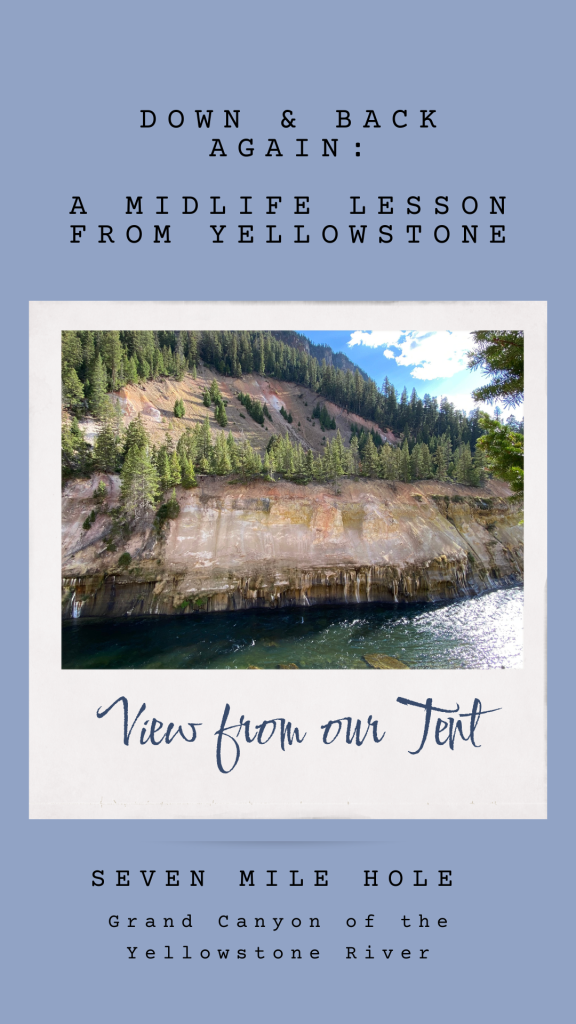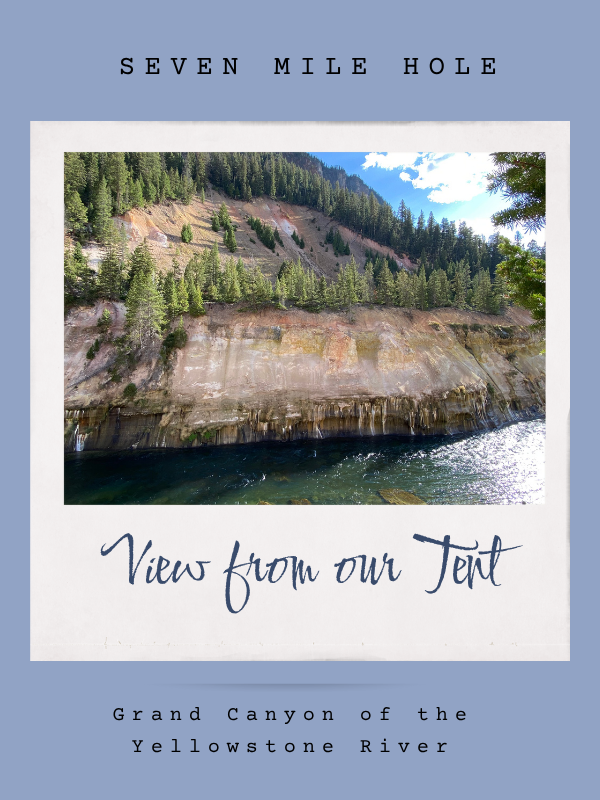Going Down
I’m not sure I’d even heard of Seven Mile Hole, a challenging trail into the Grand Canyon of the Yellowstone River, until I was in my thirties—a decade when I was still a reluctant hiker, a very reluctant hiker. By my mid-forties, I had developed an affection for hiking but dismissed Seven Mile Hole as a path I would never go down because it was out of my league, far out of my league. When I reached my fifties, it had become a trail I wanted to say I’d done more than a destination I wanted to put the work in to hike to–mostly because it sounded tough. But last fall, when I was fifty-five and deep into midlife, I successfully upped my hiking game enough for my husband and I to put Seven Mile Hole on the list for 2025.
A few weeks before our Yellowstone departure, I (probably with at least a hint of pride) told my son Seven Mile Hole was on the agenda. In response, he told me that we should make it a backcountry camping trip—as long as we were taking the trail. In other words, instead of carrying only ourselves, some water, and a day’s worth of trail food, we would be hauling everything we needed to survive the day, the night, and the next day down into the canyon on our backs—my husband’s and mine.
Like many of Yellowstone’s trails, Seven Mile Hole is something of a deceptive label. It’s neither a descent of seven miles nor a seven-mile-long trail. It’s a five-mile trail located seven miles downstream from the falls. Even so, it’s a strenuous journey. Up until this hike, I’d carried little more than water—and usually not even that. Moving up to hauling a percentage of our necessary supplies on my back on a trail characterized by hikers as five miles in and thirty-five miles out gave me just a wee bit of concern.
Finding Limits
Given that, I was delighted with my pace and stamina, and told Jaime I didn’t want to stop for lunch and a rest until we entered the canyon. The initial three-and-a-half miles went quite smoothly, but when we left the gentle ups and downs of the canyon rim and began our descent, our progress slowed to an immediate near-crawl. Downhill travel over a slope covered in scree (small, gravel-sized rock) is my nemesis when carrying nothing but myself. The pack on my back felt like a giant hand trying to push me over my poles and down the hill. Between my teeny-tiny, scree slope steps, and the weight on my back, I was not only slow, I was also in very real danger of toppling over headfirst—Westley and Buttercup style.
Not far into the canyon, we stopped for lunch, and when we finished, I went to “find a tree,” which is hiker-speak for “find the ladies’ room.” Upon my return, I found my husband standing next to the trail—his pack on his back and mine in one hand. He’d concluded the only way we’d make it would be for him to carry the pack and me to focus on walking, which, thanks to my hiking poles, I could do with an impressive speed and stability. “Are you sure?” I asked. ”It’s either this or not go,” he said. “Downhill is not your friend.”
So down we went, with him bearing my backpack. When we arrived at our backcountry campsite, a little oasis in the rocky canyon face perched above the Yellowstone River, he unzipped a side pocket of his pack, pulled out our first aid kit, and ripped open a package of ibuprofen for his stiff, overworked shoulder before heading down to the river to fish and filter water. In his twenties, this may not have been necessary, but in our twenties, we wouldn’t have been there. Some things only become possible with age.
After a surprisingly good night’s sleep, we visited over leisurely cups of hot coffee while we rehydrated pouches of biscuits and gravy and sausage and egg breakfast skillet. Then we broke camp and headed out while it was still early—before the sun unleashed its unseasonable heat on the backcountry geyser basin we needed to navigate on the return trip.
Grace and Grit in Midlife
As I carried my pack—over the scree, through the basin, up the intense switchbacks—I realized I’d learned a little about bearing on another’s burdens. My husband had simply picked up and carried what was threatening to knock me over and keep us from the destination. And, without protest, I had let him—something a seasoned through-hiking friend later told me was a mark of maturity (yay for midlife!). I still had to get where I was going. I still had to do the work of getting down a difficult slope. And thanks to my husband and my hiking poles, I carried myself and my pack out of the canyon and back to the trailhead.
This is how we reach the destination—watching for the things that threaten to knock us down, assisting one another where we can, accepting help so we have what we need to carry our own load when the time comes. This is walking worthy. Together. What’s true on the trail is true in life: Whether we’re hiking or walking through life together, practice leads to improvement.
🥾 If Yellowstone speaks to you, join me for more reflections on what’s true on the trail—and in life.
take heart & happy trails ~ Natalie
p.s. Read more about the Seven Mile Hole Trail here. This is from the National Park Service–always a good place to start!
This post is linked @ Grace & Truth.
Pin this ->

